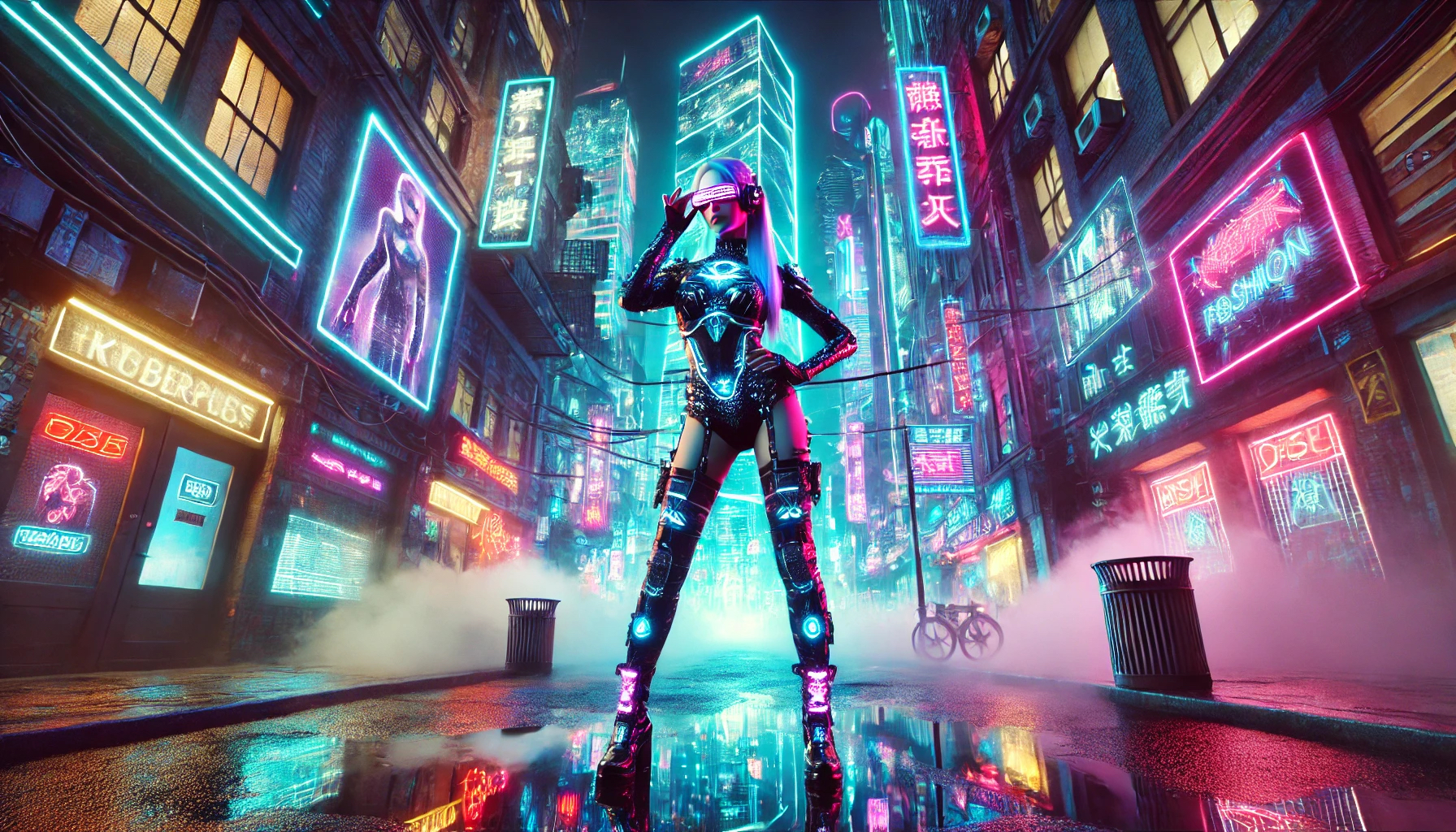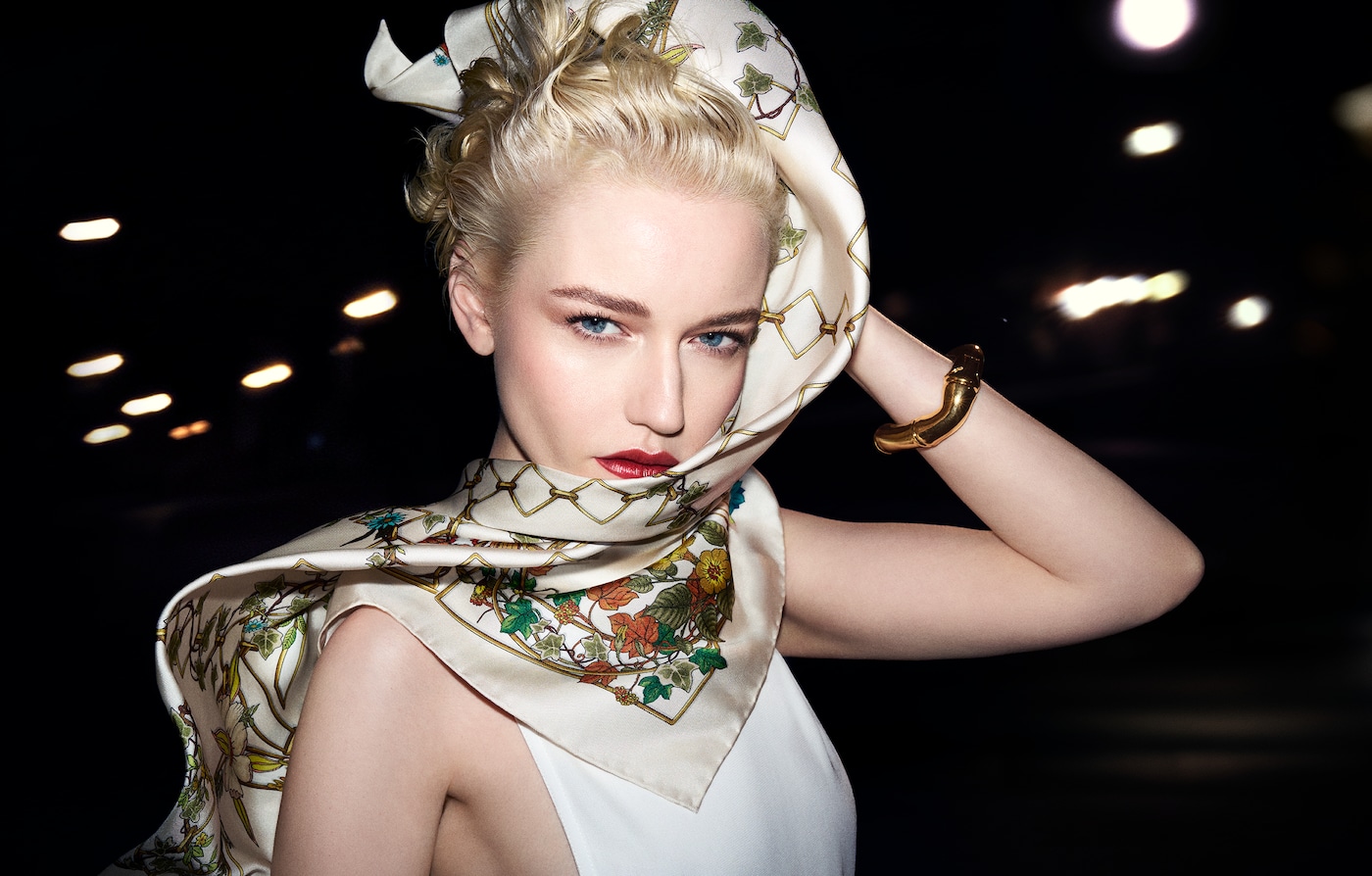Steeped in inspiration from futurist filmmakers like Ridley Scott in Blade Runner and Lana and Lilly Wachowski in The Matrix trilogy, cyberpunk fashion is integrated in popular culture for its unapologetic rebellion and neon-lit accent in technology and corporate sovereignty.
Cyberpunk fashion, an aesthetic born from the cultural movement of the 1980s, represents a fusion of futuristic technology and dystopian rebellion. Originating from the cyberpunk genre’s themes of urban decay, corporate dominance, and human-machine integration, the style first gained prominence through films such as Blade Runner.
Designers such as Michael Kaplan, Yohji Yamamoto, and Rei Kawakubo further propelled cyberpunk fashion into the mainstream by incorporating deconstructed silhouettes, high-tech fabrics, and dark, utilitarian elements into their designs. Over time, the aesthetic has evolved from an underground movement into a global fashion statement, embraced by luxury brands like Balenciaga and collaborations like CD Projekt Red X Yohji Yamamoto’s Y-3 line.
At its heart, cyberpunk fashion emphasises individuality, rebellion, and resilience in a hyperconnected world. Its distinctive features—dark palettes with neon accents, layered silhouettes, and tech-inspired accessories—symbolise the tension between societal decay and technological innovation. This aesthetic challenges traditional beauty standards and also critiques mass consumerism and corporate greed, offering a vision of self-expression in an increasingly digital and commodified world.
TABLE OF CONTENTS
- The Origin and History of Cyberpunk Fashion
- Key Features of Cyberpunk Fashion
- The Philosophy Behind Cyberpunk Fashion
- The Future of Cyberpunk as a Fashion Ge
The Origin and History of Cyberpunk Fashion
Cyberpunk fashion originated as an extension of the cyberpunk literary and cultural movement that emerged in the Eighties. The term “cyberpunk” was popularised by author Bruce Bethke and cemented by William Gibson’s seminal novel Neuromancer, which envisioned a dystopian, high-tech future marked by corporate dominance and urban decay.
This gritty, futuristic aesthetic quickly made its way into pop culture, fueled by iconic films like Blade Runner (1982), which influenced the visual language of cyberpunk fashion. In Blade Runner, costume designer Michael Kaplan mixed punk-inspired elements—such as torn fishnets, leather jackets, and asymmetrical silhouettes—with futuristic accents like metallic fabrics and synthetic textures, creating a timeless cyberpunk look that continues to shape the style today.
Cyberpunk fashion gained traction in the late Twentieth century as punk and goth subcultures embraced its rebellious, anti-establishment ethos. Japanese fashion designers like Yohji Yamamoto, Rei Kawakubo of Comme des Garçons, and Issey Miyake began incorporating futuristic and avant-garde elements into their designs, combining minimalism with exaggerated silhouettes and experimental materials. Rei Kawakubo’s collections, for example, featured deconstructed garments and dark colour palettes that mirrored cyberpunk’s dystopian themes.
Meanwhile, Vivienne Westwood, known as the queen of punk fashion, also embraced cyberpunk aesthetics in her designs, merging her trademark punk elements with high-tech influences, making her one of the pioneers in introducing cyberpunk concepts into high fashion.
Recently, cyberpunk has become a defining influence in streetwear and high fashion through collaborations and capsule collections. For example, Raf Simons, a fashion designer known for his futuristic approach, incorporated cyberpunk-inspired elements in his collections, drawing from The Matrix and dystopian imagery. The luxury brand Balenciaga also embraced cyberpunk aesthetics under Demna Gvasalia’s direction, integrating dystopian motifs and futuristic silhouettes into their designs.
CD Projekt Red, the creators of the video game Cyberpunk 2077, partnered with Japanese streetwear brand Yohji Yamamoto’s Y-3 line, producing a collection that embodied the gritty, neon-lit, and tech-inspired essence of cyberpunk. These examples show how cyberpunk fashion has evolved from its underground roots into a global aesthetic embraced by avant-garde designers and major fashion houses.
Key Features of Cyberpunk Fashion
Cyberpunk fashion is defined by its fusion of futuristic, high-tech elements with rugged, dystopian aesthetics, reflecting the “high-tech, low-life” ethos of the genre. One of its primary features is its dark and edgy colour palette, dominated by black, gray, and metallic shades. These muted tones are often contrasted with neon accents, evoking the neon-lit cityscapes of cyberpunk media such as Blade Runner.
Cyberpunk apparel features geometric patterns, asymmetrical cuts, and form-fitting designs, emphasising the intersection of technology and the human body. Materials like leather, PVC, latex, and metallic fabrics are commonly used, symbolising a gritty yet futuristic world. Another key feature is its emphasis on utility and layering.
Garments often include tactical elements like straps, buckles, zippers, and cargo pockets, combining functionality with style. Layering oversized coats, trench coats, or distressed jackets over sleek bodysuits creates a dynamic silhouette that is practical and visually striking. Accessories like harnesses, tactical vests, and belts further enhance this utilitarian aesthetic.
Tech-inspired accessories are pivotal. Augmented reality goggles, cybernetic-inspired visors, LED-lit jewellery and prosthetics are frequently incorporated into the look. Footwear is equally striking, often combat boots, platforms, or futuristic sneakers with intricate detailing. Hair and makeup also play a role in completing the aesthetic, with bold, avant-garde hairstyles, brightly dyed hair, and graphic eyeliner reflecting the defiant, rebellious spirit of the subculture. These features combine to create a style that is futuristic, utilitarian, and deeply rooted in the dystopian cyberpunk narrative.
The Philosophy Behind Cyberpunk Fashion
At its core, cyberpunk fashion is about individuality and rebellion. It embodies the tension between advanced technology and human identity, reflecting the cyberpunk genre’s themes of dystopia, corporate control, and urban decay. The style challenges traditional beauty standards and mainstream fashion ideals by embracing asymmetry, deconstruction, and the fusion of natural and synthetic materials.
Cyberpunk fashion highlights the “high-tech, low-life” ethos, symbolising a world where technology exists not as a luxury but as a survival tool for the marginalised. This philosophy aligns with the anti-establishment attitudes of punk subculture, combining it with a futuristic outlook that envisions the blend of humanity and machine.
Cyberpunk fashion is not just a fashion trend but a commentary on the social and political implications of technological advancement. It serves as a form of self-expression that questions authority, corporate greed, and conformity in an increasingly digital world. By incorporating elements like utilitarian design, augmented accessories, and rugged materials, cyberpunk fashion represents adaptability and resilience in a chaotic, hyperconnected society.
The emphasis on customisation and individualism in the aesthetic allows wearers to create unique identities in a world that often commodifies individuality. In this way, cyberpunk fashion is both a rejection of mass-produced consumer culture and a vision of a future where personal expression and technology intersect in dynamic and meaningful ways.
The Future of Cyberpunk as a Fashion Genre
The evolution of cyberpunk fashion has led to its modern manifestation in the form of “techwear,” a genre that integrates the aesthetics of futuristic dystopias with functional, technology-driven apparel and accessories. As many argue, we are living in a world that resembles the dystopian themes depicted in cyberpunk media, from urban decay to corporate dominance. Techwear represents the real-world application of these ideas, combining innovative fabrics and utilitarian designs to create apparel and accessories that reflect modern technology and the imagined future of cyberpunk.
One of the strengths of this evolution is the way techwear resonates with the cyberpunk ethos. Online communities of techwear enthusiasts share imagery, ideas, and product reviews through social media platforms, disrupting traditional corporate-driven fashion narratives. This grassroots approach to fashion inspiration mirrors cyberpunk’s anti-establishment ideology and highlights the democratisation of fashion in a hyperconnected world.
Furthermore, techwear’s urban focus—embodying weather resistance, practicality, and adaptability—aligns with the gritty, urbanised landscapes typical of cyberpunk settings. Brands like Riot Division and Raf Simons, whose 2018 collection drew direct inspiration from Blade Runner, demonstrate how techwear and cyberpunk aesthetics overlap, combining high fashion with utilitarian streetwear.
By integrating cyberpunk’s themes of technology and rebellion into functional, modern clothing, techwear ensures the genre remains relevant to contemporary contexts. Whether in the form of weather-resistant urban apparel or high-fashion pieces inspired by iconic cyberpunk media, the style continues to evolve as a reflection of society’s ongoing relationship with technology. Cyberpunk may have shifted in focus, but its influence persists, ensuring its legacy as a genre that bridges fiction, fashion, and functionality.
Jasmeen Dugal is Associate Editor at FashionABC, contributing her insights on fashion, technology, and sustainability. She brings with herself more than two decades of editorial experience, working for national newspapers and luxury magazines in India.
Jasmeen Dugal has worked with exchange4media as a senior writer contributing articles on the country’s advertising and marketing movements, and then with Condenast India as Net Editor where she helmed Vogue India’s official website in terms of design, layout and daily content. Besides this, she is also an entrepreneur running her own luxury portal, Explosivefashion, which highlights the latest in luxury fashion and hospitality.










